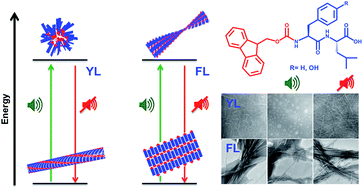Transient supramolecular reconfiguration of peptide nanostructures using ultrasound†
Abstract
Ultrasound, i.e. high frequency oscillating pressure waves, is commonly used to overcome kinetic barriers associated with dissolution, assembly and gelation. We demonstrate that ultrasound energy may also be used to achieve transient reorganization of supramolecular nanostructures, which revert back to the original state when sound is switched off. Aromatic peptide amphiphiles, Fmoc-FL and -YL were used to study the transient acoustic response. These systems showed temporary supramolecular transitions that were sequence dependent. The changes observed were due to an altered balance between H-bonding and π-stacking, giving rise in changes in chiral organisation of peptide building blocks. Transient reconfiguration was visualized by TEM and changes in supramolecular interactions characterized by fluorescence, FT-IR and CD. Remarkably, significant differences are observed when compared to thermal heating, which relates to the oscillating and directional characteristics of ultrasound when delivering heat to a system.


 Please wait while we load your content...
Please wait while we load your content...